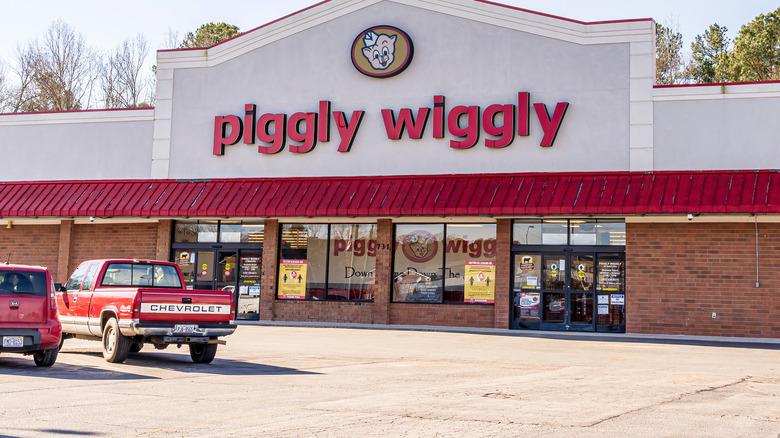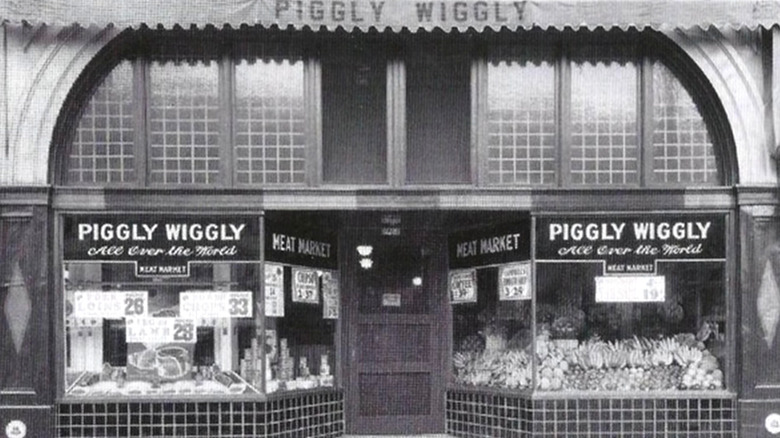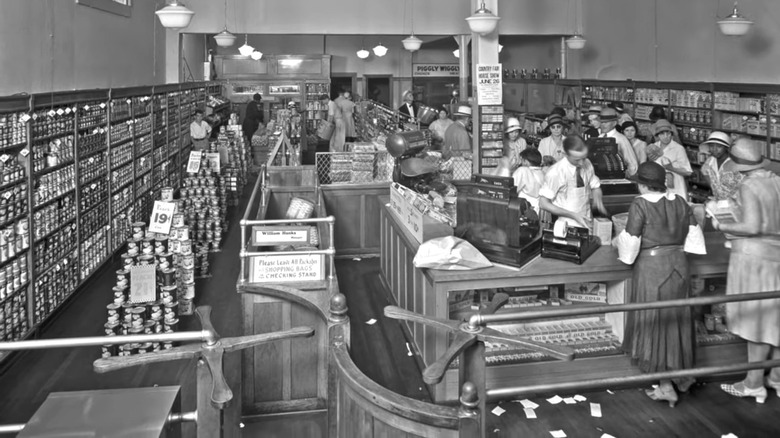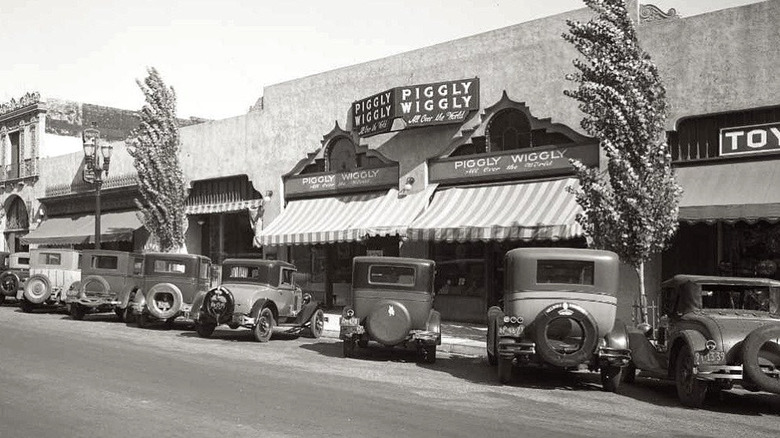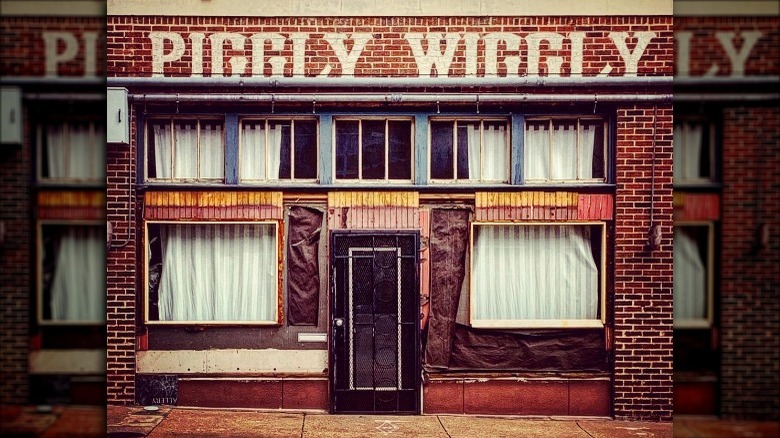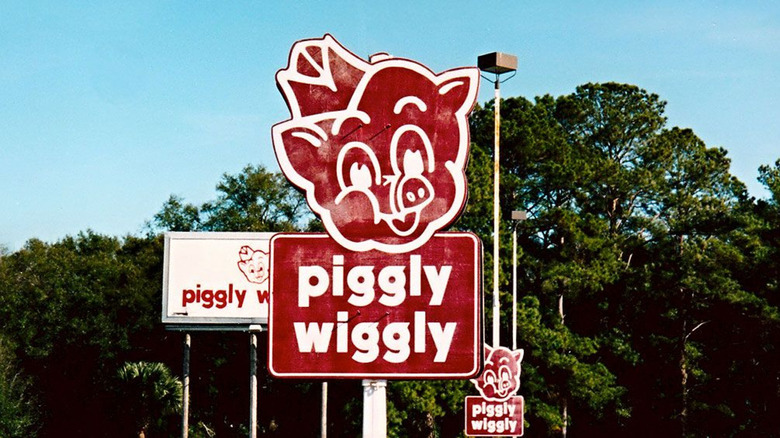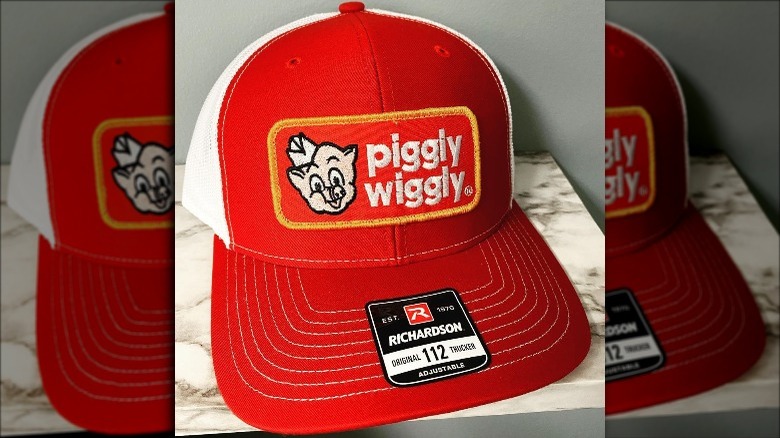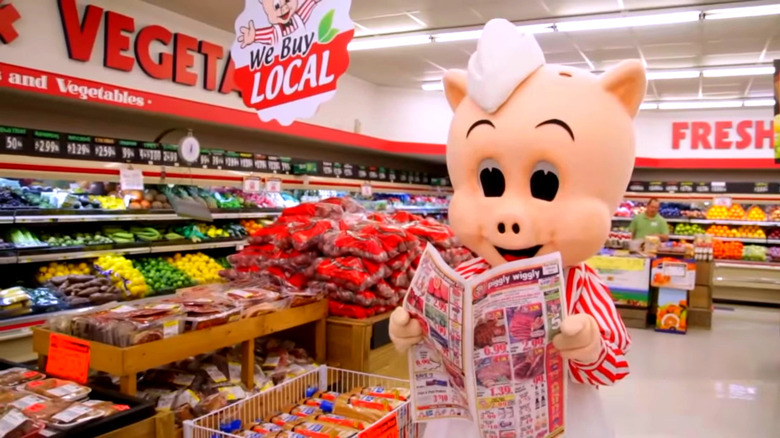The Untold Truth Of Piggly Wiggly
Grocery shopping doesn't get a lot of people excited. You might say that nothing is more mundane: We make a list, go to the supermarket, and search the shelves for the items on our list. (More accurately, we know exactly where everything is on the shelves because we've already done this exact same thing in the exact same store, countless times.) We pay for it all at the checkout stand, then we load up the vehicle and take it home. The grocery routine is so commonplace it feels natural — that is, If you accept the whole global food supply chain as "natural." Filling our carts with food items we pull ourselves from a store's shelves is the closest some of us will ever come to hunting and foraging.
The grocery store is so deeply ingrained in our day-to-day lives that it's easy to forget that Americans didn't always shop this way. A century ago, the errand some might even call "boring" was in the throes of a revolution. Pulses no doubt quickened as people first set foot in a store that offered a bold new way to shop for food. The idea caught on immediately. The store's owner attained celebrity status and was hailed as a genius (via Tennessee Historical Quarterly). The name of this great innovator may have gotten obscured over the years, but many people still know his store very well. He called it Piggly Wiggly.
Why Piggly Wiggly was a revolution
Piggly Wiggly's concept was as inspired as its name. Both were the brainchild of Clarence Saunders, a Memphis businessman who helped grow a couple retail and wholesale grocery businesses before coming up with a new way to shop, as told in historian Mike Freeman's book "Clarence Saunders and the Founding of Piggly Wiggly" (via Google Books). In 1916, the rising cost of groceries was a problem. At that time, grocers went through the store themselves to fill a customer's order. Sometimes they even delivered the order to people's homes. Saunders surmised that prices were high because stores had too many employees — clerks and delivery boys who were paid to goof off whenever business was slow. Saunders wondered, why can't customers pick the groceries off the shelves themselves? That would be a cheaper way to run a store, and the savings could be passed on to the customer.
Saunders' new Piggly Wiggly would be a self-service grocery store — a concept we completely take for granted now. At the time, it was so new that Saunders needed to pitch the idea in newspaper advertisements before the store's grand opening on September 6, 1916. He touted the cost savings, the convenience, and the freedom found in the Piggly Wiggly shopping experience. No longer will clerks select stale items for you, or the most expensive. With freedom of choice as a selling point, Saunders stocked his first store with more than 1,000 different products — about four times as many as traditional stores at the time.
Piggly Wiggly introduced many grocery-store firsts
The self-service concept brought several other firsts to the grocery business: shopping baskets, employee uniforms, and prices labeled on every item, according to Time. A Piggly Wiggly in Oklahoma would roll out the first shopping cart in 1937: two shopping baskets, one above the other, attached to a metal frame on wheels (via Harvard Business Review). Piggly Wiggly's website boasts two other innovations. The chain introduced refrigerated cases and a business model that has became the industry norm: Sell at a high volume and a low profit margin.
Piggly Wiggly ushered in still other firsts that weren't necessarily positive. If you've ever been annoyed by TV commercials that clamor for you to buy this or that product, you might be interested to know that Piggly Wiggly deserves some of the blame. Self-service grocery shopping "meant consumers could make decisions as to what it was they wanted to buy, and that really led to companies trying to catch consumers' attention. It's really the origin of branding," John Stanton, professor of food marketing at Saint Joseph's University, told Time. Also, Saunders started a grocery store practice we're only too familiar with today: putting candy and other impulse items at the checkout stands.
Saunders' new way to shop was tremendously successful. He had opened nine stores within his first year of business (via Tennessee Historical Quarterly). Seven years in, Saunders led a $100 million company with 1,268 stores.
Piggly Wiggly's founder tried to grab attention with that strange name
Now for a plot twist: Piggly Wiggly founder Clarence Saunders didn't invent the self-service grocery store after all, according to Tennessee Historical Quarterly. Even so, histories written in publications such as Time and Smithsonian give Saunders the credit. As it turns out, a grocer in southern California opened a self-serve store in 1915. It's just that you'd be hard pressed to find someone today who has ever heard of the Alpha-Beta store, where all items were stocked in alphabetical order. "A good idea never amounts to much until it gets a good campaigner behind it," the editors of Judicious Advertising wrote in 1918, per Tennessee Historical Quarterly. "Mr. Saunders appears to be the first man who has given this grocery idea a real run for its money."
One thing that probably helped Piggly Wiggly catch on, when Alpha-Beta didn't, was the store's downright weird name. Weeks before opening his first store, Saunders had a curious billboard put up in Memphis that read, "Piggly Wiggly" (via Google Books). A later billboard got more to the point: "Mrs. Brown asked Mr. Brown to stop by the Piggly Wiggly on the way home." People in Memphis must have been asking themselves, "What on Earth is a Piggly Wiggly?" In a newspaper ad that ran a few days before the first grand opening, Saunders highlighted the strangeness of the name: "Piggly Wiggly ... ain't that a funny name? The fellow that got up that name must have a screw loose somewheres."
Why was the store called 'Piggly Wiggly'?
Clearly, the Piggly Wiggly name was meant to be an attention-getter. In the Tennessee Historical Quarterly, Piggly Wiggly historian Mike Freeman described Saunders as someone who preferred the startling turn of phrase over the bland. That might tell you everything you need to know about why Saunders chose the name "Piggly Wiggly." He certainly wasn't going to give anyone a satisfying answer when asked about the name. "Plucked from originality," he said once. "From out of chaos," he said another time. Yet another time, he might have been admitting that he chose the name simply because it was a conversation starter. "So people like you can ask me that question," he said. Competitors laughed at the name, saying it brought to mind a "carnival house for tots" more than a grocery store (via Google Books).
Legend — and the Piggly Wiggly website — has it that the name "Piggly Wiggly" came to Saunders on a train ride, when he looked out the window and saw several pigs trying to wiggle under a fence. Freeman, in his book "Clarence Saunders and the Founding of Piggly Wiggly," speculated that Saunders may have been inspired by the old nursery rhyme that starts "Higgledy piggledy, my fat hen," or by "Uncle Wiggily's Adventures" (via Newspaper Comic Strips), a regular feature in a Memphis newspaper that Saunders read to his children. "Clarence Saunders had found a name so unique, everyone would remember it and identify it with him," Freeman wrote.
Today, Piggly Wiggly is mainly a southern grocery store
Piggly Wiggly was born in the South in 1916, then grew so fast it was in every region of the U.S. by the end of 1918 (via Tennessee Historical Quarterly). By 1923, Piggly Wiggly was the third largest retail grocer in the U.S. The chain wasn't able to maintain its dominance for long, however. Piggly Wiggly stores were held by various franchise owners, and other big chains started buying them out. Safeway acquired more than 200 stores in California from the Piggly Wiggly Western States Company in 1929 (via Daily Breeze). Before that, Kroger had snatched up all the Piggly Wigglys in Memphis and Mississippi, plus several other stores in the southeast, according to the Jackson Clarion-Ledger. Kroger also took over the 31 Piggly Wigglys in Columbus, Ohio (via The New York Times).
Today, Piggly Wiggly's name is on a relatively modest 498 storefronts in 17 states — most of them in the South (via ScrapeHero). These numbers include stores operated by a separate company called Piggly Wiggly Midwest. This outfit and its franchisees have 96 Piggly Wigglys, according to the Midwest company's website, almost all in Wisconsin. The southern Piggly Wigglys (and a scattered few in Ohio and West Virginia) are branded by parent company C&S Wholesale Grocers, according to that Piggly Wiggly website.
Bill Murray made a Piggly Wiggly fashion statement
A name like Piggly Wiggly affords a tremendous amount of brand appeal. Comedian and actor Bill Murray was just being his offbeat, goofy self when he was caught by TV cameras at a college basketball game in 2019 wearing a Piggly Wiggly trucker's cap. Murray calls South Carolina home — a state that's also home to dozens of Piggly Wiggly stores — so the look actually made some sense. (It's easy to imagine Bill Murray shopping for himself at Charleston's Piggly Wiggly.) The Hilton Head, South Carolina Piggly Wiggly's website shows an extra-large area of the store devoted to T-shirts, tank tops, and baby clothes featuring the iconic Mr. Pig logo. This part of the Hilton Head Piggly Wiggly no doubt appeals to northern tourists who want something quirky that says "I spent my vacation down south."
Piggly Wiggly's porcine mascot with the butcher's hat that somehow manages to be unironic also appears in TV commercials and makes store appearances (via PR Week). Piggly Wiggly takes its mascot seriously enough that it decided in 1998 to cast him as a little bit thinner, so he might appeal better to consumers. The pig's face can be found on just about everything associated with Piggly Wiggly, including his namesake store-brand soda. Mr. Pig is Piggly Wiggly's version of Dr Pepper (via Reddit).
Piggly Wiggly prides itself on customer service
Piggly Wiggly embarked on its first national TV ad campaign in 1997, according to Supermarket News. The ads came with a tagline that played up the chain's rural, small-town identity: "Down home, down the street." The campaign was a response to the rise of large, impersonal superstores. "There is a place in people's lives for a traditional supermarket, one that is friendly and convenient like Piggly Wiggly," company president Larry Wright said at the time. "It's time to make the neighborhood store mean something again."
CBS 42 in Birmingham, Alabama (posted on YouTube) interviewed a longtime employee during a report on a neighborhood Piggly Wiggly closing its doors. The employee said customer service made the small store stand out. "We can't keep up with the big boys — Publixes, Walmarts, whatnot," he said. "They would offer more, but we like to pride ourselves in how we treat our customers."
Piggly Wiggly has come full circle. A century ago, as Mike Freeman tells it in his Piggly Wiggly history (via Google Books), the store's founder required employees to be courteous and polite in order to separate themselves from some of the unscrupulous grocers who still pulled items off the shelves for their customers — and took advantage of them while doing it. Today, politeness and courtesy still define the Piggly Wiggly way of doing business. Except now Piggly Wiggly is the old-fashioned one, trying to create some wiggle room for friendliness among the Publixes and Walmarts of the grocery world.
